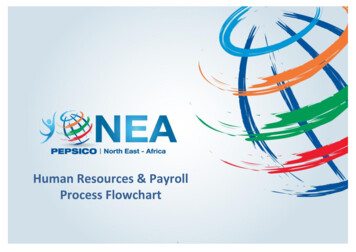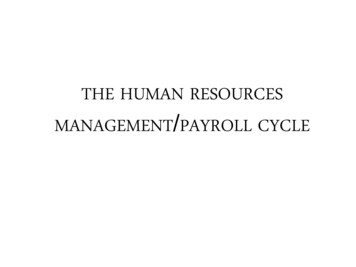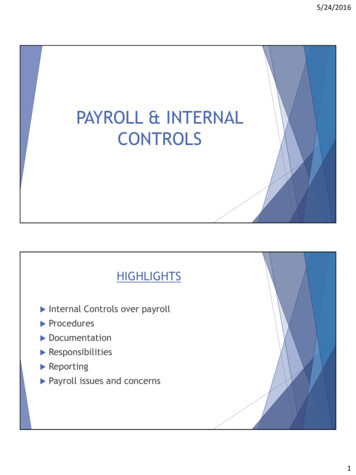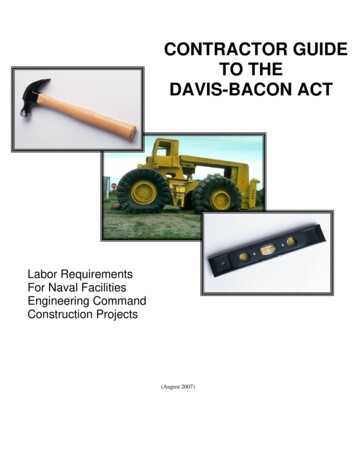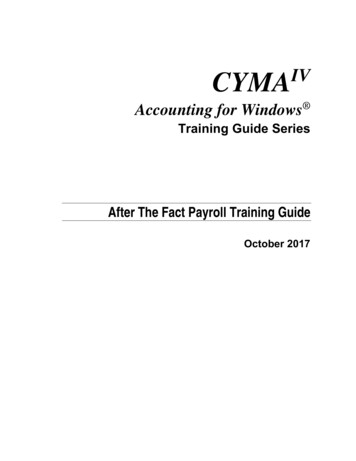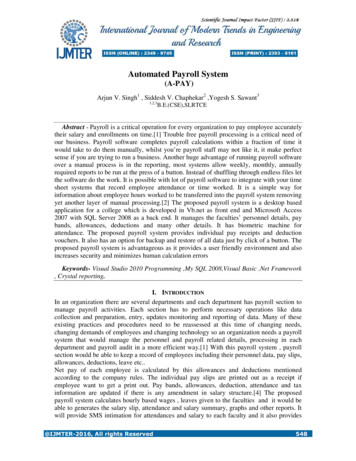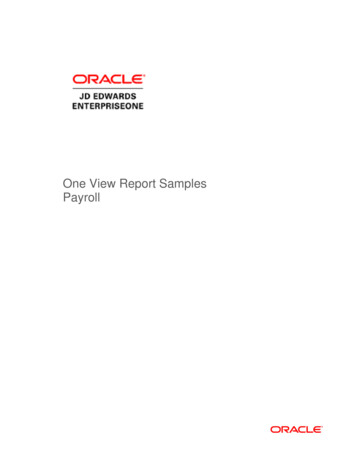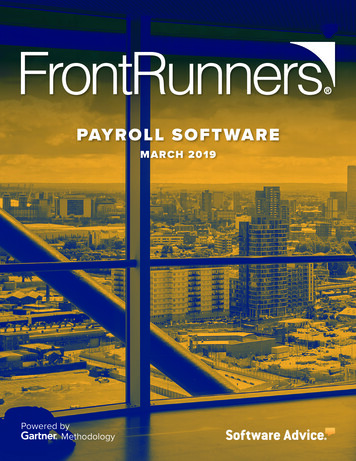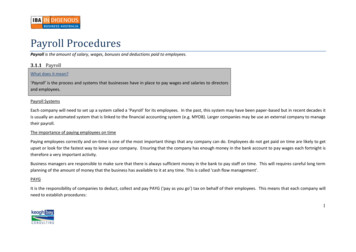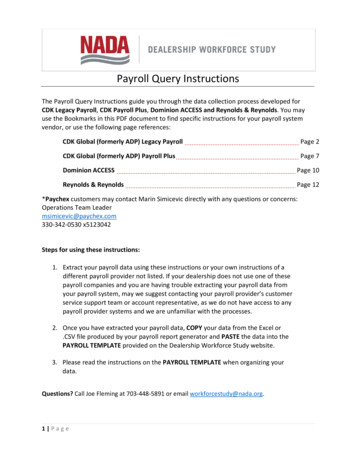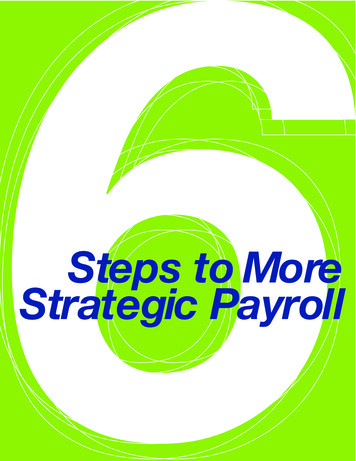
Transcription
Steps to MoreStrategic Payroll
Across all industries, analystsagree that payroll departmentsare hamstrung by time sks.resourcesandmanpower, while incurring substantial opportunitycosts as your payroll team could be spending time onmore strategic contributions. These activities are alsoprone to manual errors, requiring duplicate dataentry and inefficient workflows just to see themthrough to completion. Convoluted technology inpayroll processes—maybe the most ubiquitous ofall business practices—can translate to ches when it comes to tax reporting season oryear-end.Technology should empower payroll to become amore strategic asset, not act as a barrier. Byadopting the following payroll best practices, yourorganization can become more efficient and cutcosts without adding complexity, and leverage thefull potential of payroll by shifting the burdenfrom administrative tasks to strategic goals.
Unify payroll data withcore HR olutions fall flat because, despite robustfeatures and configurability, they fail to act in concertwith your other data to form a cohesive whole.Indeed, at many companies HR is thought of as theteam that manages your people data, and payroll asthe team that ensures they get paid, with little to nothinglinking the two. Instead, your organization should takeadvantage of a solution that unifies payroll and HR data inone single system of record, eliminating numerousinefficiencies in the process.Each separate system utilized for an individual taskequates to hours of training, support, and confusion wheninterfaces or information don’t line up properly. Often,manual corrections are needed to get these systems toeffectively work together, leading to even more reductionsin productivity. For example, the seemingly simple processof setting up a new employee in your recordkeepingsystem can involve an unexpected amount of crosstalkbetween HR and payroll, which means more room tion between core HR tasks and your payrollteam, activities as diverse as monitoring time andattendance and tax reporting can be performed "under
one roof,” with a unified user experience accessiblethrough the Web. The streamlining and simplificationassociated with unifying payroll and HR can utcanalsosavebusiness overall. Inaddition to the reclaimed opportunity costs and reducedwaste, companies that take advantage of unified payrollsolutions also simply spend less on payroll peremployee per year.
Embrace the cloud forall payroll activitiesCloud-based delivery has revolutionized the processing of payroll tasks and the storage of payroll data.While on-premise payroll requires more training andmaintenance with each new location, a single cloudbased solution encompassing all of your payroll needswill further reduce time spent on administrative tasksand allow your team to focus on strategic planningactivities.With the cloud, access to any activity, from viewingpayroll calendars to processing individual pay groups, isavailable from anywhere, anytime. This gives all payrollmanagers the ability to strategically manage the needsof different groups of employees, while executives canrun and review reports on payroll metrics across theentire company rather than settling for isolated pieces ofinformation available to a localized system.
The cloud provides seamless, centralized accessto payroll processes for the entire organization. Thiseliminates delays in processes which can occurwhen replicating data across databases, providesconvenient access when dealing with employeesin foreign countries, and allows processing to beperformed exactly when it needs to be, rather thanbeing constrained to business hours. All of thistranslates to reduced administrative overhead foryour payroll professionals, and more time spentadvancing your overall business goals.
Eliminate unnecessaryor redundant stepsPayroll processing, even for very complex organizations, should be measured in minutes and hours,notdaysorweeks.Butthebranches, mergers, recandifferent payroll processingschemes for different areas of the company. And if anyof these areas used outdated or incompatible tax-filingor reporting systems, processing can come to agrinding halt while all of the workflows and data streamsare reconciled. Systemically eliminating this redundancyin favor of employing a single, straightforward procedureregardless of pay group or location is a crucial bestpractice when transforming payroll into a morestrategic force.A unified, cloud-based solution can automaticallyretrieve time and attendance data for processing ltiplethatmayhavespreadsheetsandmanual data entry from disparate systems. Payroll
adjustments can be made at any time, so an entire processdoes not need to be aborted to make small modifications. Youcan also take advantage of the wealth of people dataavailable and create payroll models—bundling many stepsinto one—that can be reused when setting up new employeegroupsratherthanstartingfromscratch.In addition to unifying your data, your company maywish to consider consolidating pay cycles so that lessprocessing is necessary overall. Monthly or bimonthly payperiods can save substantial overhead, especially if yourbusiness involves many pay groups for different kinds ofemployees. Many companies are eliminating the printingof paper checks altogether, using direct deposit andother electronic means to reduce paper waste and cut yetanother step out of the process.
Empower employeeswith access to theirown dataIt may be surprising to hear that a best practice forstrategic payroll might involve employees outside ofpayroll entirely, but consider this: every minute yourpayroll professionals spend on the phone or answering anemail to give employees pay information or instructionson how to use their system is time that could be spent onmore strategic activities. Every time an employee contactspayroll to request information they could have obtainedthemselves, it means lost productivity on the payroll side.By taking advantage of a payroll solution in thecloud, thesameunified,single-userexperiencedescribed above for your managers and anization. With role-based access, employees canlog in and view the important HR and compsensation
data that applies to them without needinganything other than an Internet connection.Employees can view paycheck details and paysummaries, get their W-4s and tax ionstheirhavefingertips.evenembraced mobile technology to enable the modernmulti-generational workforce to instantly view theirpay data on a smartphone or tablet.
Ensure seamlessintegration betweenpayroll and third-partyprovidersOutside of inefficiencies found in internal processes, manypayroll teams struggle to find a workable form of integration withthird-party entities such as financial institutions and benefitsproviders. Crafting improvised solutions to ensure the data gets tothe right place on-time can become a nightmare, especially ifdifferent providers require the same payroll data at different times.In the worst case scenario, managing the export and ensuringaccuracy can require custom work from your IT team.Best-in-class human capital management eliminates thesehassles by relying on secure, common Web standards for datatransfer and reconciliation, and offers a consistent interface and userexperience for setting up an integration regardless of the provider inquestion. Company-wide payroll data may be exported to a generalledger, and then effortlessly connected to an insurance provider foropen enrollment, a bank to set up recurring direct deposits, and so on.Combining and streamlining your payroll team’s third-partyintegration processes can ensure reliable exports of data for criticalservices, while freeing up valuable resources that can be devoted toother tasks.
Leverage reporting andanalytics to optimizeperformancePayroll is all-too-frequently overlooked when itcomes to analyzing critical company data at thecorporate level for strategic insight. The truth is thatpayroll data can be just as valuable as any other form oftrend analysis. Embraced by organizations that havelearned how to get the most from their human capital,this best practice leverages your payroll information asone piece of a larger puzzle; using hard data to assistyour executives in making decisions that align withthe strategic goals of your business. A best-in-class,cloud-based unified payroll solution will include theseanalysis and reporting capabilities to give youimmediate access to the metrics you need.With powerful business intelligence tools, yourpayroll managers can create strategic reports thatfocus on departmental or company-wide factors andanswer key questions for maximizing efficiency and
growth. Labor costs can be applied to predictiveanalysis for new locations or hires. Trendanalysis on tax liabilities can narrow downcomplianceissuesfortargeting.Morecomplex, cross-departmental reports can beemployed to compare salary ranges betweenteams, get the most from your company budget,and even further streamline your use of payrollresources.
More than 3,000 organizations have selected UltiPro astheir payroll and HR software of choice. Industry leaders haverelied on UltiPro to serve their people management needs formore than a decade, from core HR and payroll to benefits andperformance management. Ultimate Software has a proventrack record of best-in-class functionality and outstandingcustomer service for the industry. es to maximize strategic impact Capture real-time employee information based on aplethora of demographics to stay at the forefront of industrytrends Easily integrate with your third-party systems for point-ofsale systems, timekeeping, and 401(k) providers Manage your global employees’ HR/payroll data fromanywhere with 24-7 online accessFor more information about Ultimate Software andUltiPro, please visit www.ultimatesoftware.com.
payroll processes—maybe most ubiquitous the of all business practices—can translate to hundreds of hours of lost productivity, unneeded and headaches when it comes to tax reporting season or year-end. Technology should empower payroll t
